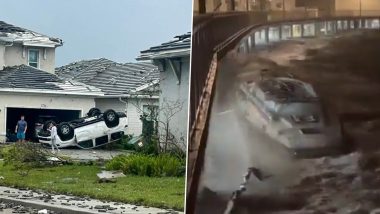Tampa, October 10: Hurricane Milton barrelled into the Atlantic Ocean on Thursday after plowing across Florida, pounding cities with ferocious winds and rain, and whipping up a barrage of tornadoes. It caused at least four deaths and compounded the misery wrought by Helene while sparing Tampa a direct hit.
The storm tracked to the south in the final hours and made landfall as a Category 3 storm Wednesday night in Siesta Key, about 70 miles (112 kilometres) south of Tampa. The situation in the Tampa area was still a major emergency as St Petersburg recorded over 16 inches (41 centimeters) of rain, prompting the National Weather Service to warn of flash flooding there as well as other parts of western and central Florida. Hurricane Milton Update: Category 3 Storm Makes Landfall Along West-Central Coast of Florida (Watch Videos).
As dawn broke Thursday, officials repeated that the danger had not passed: Storm surge remained a concern in many parts of Florida and tropical storm warnings were in place for much of the east-central coast. Officials in the hard-hit counties of Hillsborough, Pinellas, Sarasota and Lee urged people to stay home, warning of downed power lines, trees in roads, blocked bridges and flooding. “We'll let you know when it's safe to come out,” Sheriff Chad Chronister of Hillsborough County, home to Tampa, said on Facebook.
Though the deadly storm surge feared for Tampa appears not to have materialized, the city saw flooding from rain. Farther south, the Lee County Sheriff's Office reported localized flooding and storm surge, and Lorraine Anderson, the public information officer for Venice Beach, said on CNN that the area saw an estimated 6 to 7 feet (1.8 to 2 meters) of storm surge, far below the feared 15. Hurricane Milton: What’s Fueling Stronger Storms?.
The storm knocked out power across a large section of Florida, with more than 3.2 million homes and businesses without electricity, according to poweroutage.us, which tracks utility reports. The fabric that serves as the roof of Tropicana Field, home of the Tampa Bay Rays baseball team in St. Petersburg, was ripped to shreds by the fierce winds. It was not immediately clear if there was damage inside. Multiple cranes were also toppled in the storm, the weather service said.
Hurricane Milton Ravages Florida
🚨🇺🇲 #Hurricane #Milton, Here are some images of the damage caused by HURRICANE Milton, Thank God it was degraded and did not turn out to be as powerful as expected... We wish a speedy recovery to all those affected 🙏🙌#HurricaneMilton #florida #Sarasota pic.twitter.com/kvi7194IQd
— CRISTIAN REAL OFICIAL (@CRISTIAN_REAL01) October 10, 2024
St. Petersburg residents also could no longer get water from their household taps because a water main break led the city to shut down service. Mayor Ken Welch had told residents to expect long power outages and the possible shutdown of the sewer system. Just inland from Tampa, the flooding in Plant City was “absolutely staggering,” according City Manager Bill McDaniel. Emergency crews rescued 35 people overnight, said McDaniel, who estimated the city had received 13.5 inches (34 cm) of rain. "We have flooding in places and to levels that I've never seen, and I've lived in this community for my entire life,” he said in a video posted online Thursday morning.
Before Milton even made landfall, heavy rain and tornadoes lashed parts of southern Florida Wednesday morning, with conditions deteriorating throughout the day. One twister touched down in the lightly populated Everglades and crossed Interstate 75. Another apparent tornado hit in Fort Myers, snapping tree limbs and tearing a gas station's canopy to shreds. The Spanish Lakes Country Club near Fort Pierce, on Florida's Atlantic Coast, was hit particularly hard, with homes destroyed and some residents killed. Four people were killed in tornadoes there, the St. Lucie County Sheriff's Office said.
About 125 homes were destroyed before the hurricane came ashore, many of them mobile homes in communities for senior citizens, said Kevin Guthrie, the director of the Florida Division of Emergency Management. About 90 minutes after making landfall, Milton was downgraded to a Category 2 storm. By early Thursday, the hurricane was a Category 1 storm with maximum sustained winds of about 85 mph (135 kph) and leaving the state near Cape Canaveral.
The storm slammed into a region still reeling two weeks after Hurricane Helene flooded streets and homes in western Florida and left at least 230 people dead across the South. In many places along the coast, municipalities raced to collect and dispose of debris before Milton's winds and storm surge could toss it around and compound any damage. Officials had issued dire warnings to flee or face grim odds of survival. By late afternoon, some officials said the time had passed for such efforts, suggesting that people who stayed behind hunker down instead.
Jackie Curnick said she wrestled with her decision to stay at home in Sarasota, just north of where the storm made landfall. She and her husband started packing Monday to evacuate, but they struggled to find available hotel rooms, and the few they came by were too expensive. With a 2-year-old son and a baby girl due Oct. 29, Curnick said there were too many unanswered questions if they got in the car and left: where to sleep, if they'd be able to fill up their gas tank, and if they could even find a safe route out of the state.
Video taken during the storm showed howling winds and sheets of rain lashing their glass-enclosed swimming pool as their son and dog watched. Trees shook violently. “The thing is it's so difficult to evacuate in a peninsula,” she said ahead of the storm. “In most other states, you can go in any direction to get out. In Florida, there are only so many roads that take you north or south."
At a news conference in Tallahassee, Gov. Ron DeSantis described deployment of a wide range of resources, including 9,000 National Guard members from Florida and other states; over 50,000 utility workers from as far as California; and highway patrol cars with sirens to escort gasoline tankers to replenish supplies so people could fill up their tanks before evacuating. “Unfortunately, there will be fatalities. I don't think there's any way around that,” DeSantis said.
Authorities issued mandatory evacuation orders across 15 Florida counties with a total population of about 7.2 million people. In Orlando, Walt Disney World, Universal Orlando and Sea World remained closed Thursday. More than 60% of gas stations in Tampa and St. Petersburg were out of gas Wednesday night, according to GasBuddy, though DeSantis said the state's overall supply was fine. Officials warned that anyone staying behind must fend for themselves, because first responders were not expected to risk their lives attempting rescues at the height of the storm.
In Charlotte Harbor, about 100 miles (160 kilometers) south of Tampa, clouds swirled and winds gusted as Josh Parks packed his Kia sedan with clothes and other belongings Wednesday. Two weeks ago, Helene's surge brought about 5 feet (1.5 meters) of water to the neighborhood, and its streets remain filled with waterlogged furniture, torn-out drywall and other debris. Parks, an auto technician, planned to flee to his daughter's home inland and said his roommate already left. “I told her to pack like you aren't coming back,” he said.
(This is an unedited and auto-generated story from Syndicated News feed, LatestLY Staff may not have modified or edited the content body)













 Quickly
Quickly





















